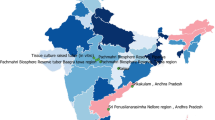Abstract
Flavoparmelia caperata (L.) Hale is medicinally very important and possesses antifungal and antibacterial activities. F. caperata is the only species found in India. Inter simple sequence repeat (ISSR) and Directed amplification of minisatellite DNA (DAMD) methods were used to analyze the genetic variability within F. caperata from the Western Himalayan region of India. Eleven ISSR and 10 DAMD primers produced 139 and 117 polymorphic bands, and detected 91.44 and 82.34 % polymorphisms, respectively. Cumulative band data generated for ISSR and DAMD markers resulted in 86.86 % polymorphism across all the accessions of F. caperata. The average Polymorphic information content (PIC) value obtained with ISSR, DAMD, and cumulative band data were 0.28, 0.27, and 0.27, respectively. The clustering of the F. caperata accessions in the UPGMA dendrogram showed that these accessions are intermingled with each other in different subclusters irrespective of their geographical affiliations. The pattern of genetic variations within F. caperata accessions could be due to free exchange of spores that might have taken place among these accessions in the wild. ISSR and DAMD markers efficiently and reliably resulted in discrete banding patterns and polymorphic profiles. These markers despite targeting different regions of genome, revealed almost similar levels of polymorphism across all the accessions. The wide range of genetic distance and high level of polymorphism detected by ISSR and DAMD reflected a high genetic variability among the different accessions of F. caperata.



Similar content being viewed by others
References
Bayraktar H, Dolar FS, Maden S (2008) Use of RAPD and ISSR markers in detection of genetic variation and population structure among Fusarium oxysporum f. sp. ciceris isolates on chickpea. Turk J Phytopathol 156:146–154
Botstein D, White RL, Skolnick M, Davis RW (1980) Construction of a genetic linkage map in man using restriction fragment length polymorphism. Am J Hum Genet 32:314–331
Cobanoglu G, Sesal C, Gokmen B, Cakar S (2010) Evaluation of the antimicrobial properties of some lichens. SW J Hort Biol Environ 1:153–158
Crespo A, Kauff F, Divakar PK et al (2010) Phylogenetic generic classification of parmelioid lichens (Parmeliaceae, Ascomycota) based on molecular, morphological and chemical evidence. Taxon 59:1735–1753
Fontaine KM, Stocker-Worgotter ET, Booth T, Piercey-Normore MD (2013) Genetic diversity of the lichen-forming alga, Diplosphaera chodatii, in North America and Europe. Lichenologist 45(6):799–813
Frankham R (1996) Relationship of genetic variation to population size in wildlife. Conserv Biol 10:1500–1508
Frankham R (1999) Quantitative genetics in conservation biology. Genet Res 74:237–244
Grube M, Hawksworth DL (2007) Trouble with lichen: the re-evaluation and re-interpretation of thallus form and fruit body types in the molecular era. Mycol Res 111:1116–1132
Hamada H, Kakunaga T (1982) Potential Z-DNA forming sequences are highly dispersed in the human genome. Nature 298:396–398
Heath DD, Iwama GK, Devlin RH (1993) PCR primed with the VNTR core sequences yields species specific patterns and hypervariable probes. Nucleic Acids Res 21:5782–5785
Honegger R, Zipper U, Scherrer, Dyer PS (2004) Genetic diversity in Xanthoria parietina (L.) Th. Fr. (Lichen-forming ascomycete) from worldwide locations. Lichenologist 36(6):381–390
Lande R (1988) Genetics and demography in biological. Conserv Sci 241:1455–1460
Mantel N (1967) The detection of disease clustering and a generalized regression approach. Cancer Res 27:209–220
Murtagh GJ, Dyer PS, McClure PC, Crittenden PD (1999) Use of randomly amplified polymorphic DNA markers as a tool to study variation in lichen-forming fungi. Lichenologist 31(3):257–267
Nash TH III, Ryan BD, Gries C, Bungartz F (2002) Lichen flora of the greater sonoran desert region, vol I. Lichens Unlimited, Arizona State University, Tempe
Page RDM (2001) TreeView (Win32), Ver. 1.6.5. Available from: http://taxonomy.zoology.gla.ac.uk/rod/treeview.html
Pavlicek A, Hrda S, Flegr J (1999) Free Tree—freeware program for construction of phylogenetic trees on the basis of distance data and bootstrapping/ jackknife analysis of the tree robustness. Application in the RAPD analysis of the genus Frenkelia. Folia Biol (Praha) 45:97–99, Available from: http://www.natur.cuni.cz/~flegr/programs/freetree.htm
Pennington CW (1963) The Tarahumar of Mexico: their environment and material culture. Univ of Utah Press, Salt Lake City
Printzen C (2002) Fungal specific primers for PCR-amplification of mitochondrial LSU in lichens. Mol Ecol Notes 2:130–132
Provost A, Wilkinson MJ (1999) A new system of comparing PCR primers applied to ISSR fingerprinting of potato cultivars. Theor Appl Genet 98:107–112
Rohlf FJ (1998) NTSYS-pc: numerical taxonomy and multivariate analysis system, version 2.02e. Applied Biostatistics Inc., Exeter Software, Setauket
Shah A, Li DZ, Gao LM, Li HT, Möller M (2008) Genetic diversity within and among populations of the endangered species Taxus fauna (Taxaceae) from Pakistan and implications for its conservation. Biochem Syst Ecol 36:183–193
Tautz D, Renz M (1984) Simple sequences are ubiquitous repetitive components of eukaryotic genomes. Nucleic Acids Res 12:4127–4138
Uphof JCT (1959) Dictionary of economic plants. Hafner, New York
Yuzbasioglu E, Halici MG, Karabacak M, Aksoy A (2011) RAPD and ISSR markers indicate high genetic variation within Lobathallia radiosa in Turkey. Mycol Prog 10:219–228
Zhou Z, Bebeli PJ, Somers DJ, Gustafson JP (1997) Direct amplification of minisatellite-region DNA with VNTR core sequences in the genus Oryza. Theor Appl Genet 95:942–949
Zietkiewicz E, Rafalski A, Labuda D (1994) Genome fingerprinting by simple sequence repeat (SSR)-anchored polymerase chain reaction amplification. Genomics 20:176–183
Acknowledgments
The authors are thankful to the Director of the CSIR-National Botanical Research Institute, Lucknow for faculties and encouragements. The financial support (No. BT/PR1457/39/204/2011) received from the Department of Biotechnology, New Delhi is gratefully acknowledged.
Author information
Authors and Affiliations
Corresponding author
Rights and permissions
About this article
Cite this article
Singh, N., Bajpai, R., Mahar, K.S. et al. ISSR and DAMD markers revealed high genetic variability within Flavoparmelia caperata in Western Himalaya (India). Physiol Mol Biol Plants 20, 501–508 (2014). https://doi.org/10.1007/s12298-014-0256-0
Received:
Revised:
Accepted:
Published:
Issue Date:
DOI: https://doi.org/10.1007/s12298-014-0256-0




